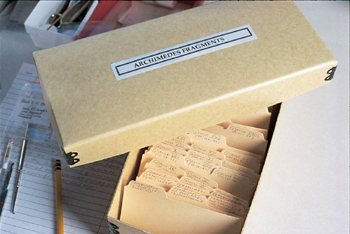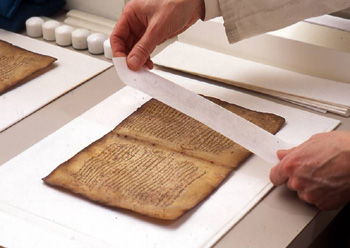The Conservation of the Archimedes Palimpsest
The conservation of the Archimedes Palimpsest is undertaken by Abigail Quandt, Senior Conservator of Rare Books and Manuscripts at the Walters Art Museum in Baltimore. Her first priority was to ensure the continued safety of a very fragile historical document. Her second priority was to prepare the manuscript for imaging. This entailed disbinding the manuscript, as the under texts run through the gutter of the book. Work on disbinding the manuscript started in February 2000, and finished in November 2004.
The Disbinding Process
When the manuscript was deposited at Christie's for sale, it lay loose in its binding. For the purposes of safe handling the book was given a conservation binding, that kept the leaves secure between its boards, but which did nothing to alter the original construction.
Having disassembled the modern construction, and having revealed the structure of the spine as it was before the sale at Christie's, Quandt could begin to separate the quires in the manuscript from each other.
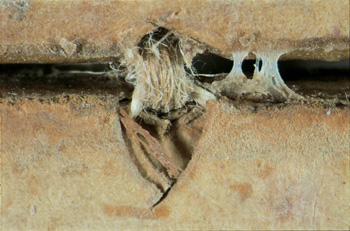
This has been the principal challenge, and the main reason why the disbinding of the manuscript has taken such a long time.
Once separated, the leaves had to be prepared for imaging. One of the first tasks was to discover the chemical in the parchment, and to discover how stable, or unstable, the manuscript actually was. This work was undertaken by the Canadian Conservation Institute, which has provided expert advice throughout the project. Here you see a core sample, the size of a pinhead, taken through the manuscript.
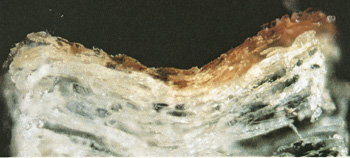
Here are some of the procedures that Quandt undertook on the leaves, illustrated with snapshots.
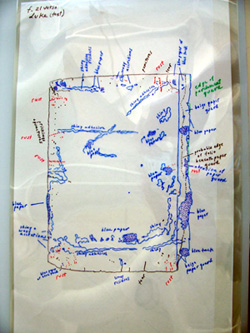 Documenting the condition of the individual leaves. Quandt draws maps of each leaf, noting where there are problems, be they mold, wax, glue, or modern residues, such as blue tack and paper.
Documenting the condition of the individual leaves. Quandt draws maps of each leaf, noting where there are problems, be they mold, wax, glue, or modern residues, such as blue tack and paper. Mechanically removing the dirty wax from the parchment. The manuscript had been used for several hundred years as a prayer book, and it was used by candlelight. Large areas were covered in wax, and it was necessary to remove the wax that obscured the under text.
Mechanically removing the dirty wax from the parchment. The manuscript had been used for several hundred years as a prayer book, and it was used by candlelight. Large areas were covered in wax, and it was necessary to remove the wax that obscured the under text.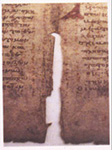
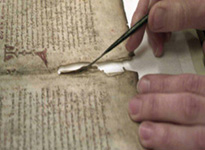

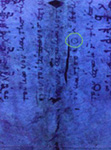
Unfolding damaged areas to reveal text. Pages of the manuscript were particularly fragile at the margins an in the gutter of the prayer book. Sometimes the parchment needed to be carefully unfolded to reveal areas that were subsequently imaged. In the illustration below, Ms. Quandt works on a small damaged area in the gutter. You see the area before treatment, during treatment, after treatment, and under ultraviolet light. The last image makes clear the Archimedes text, running vertically down the page.



